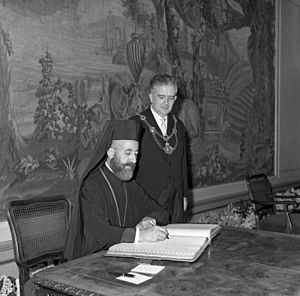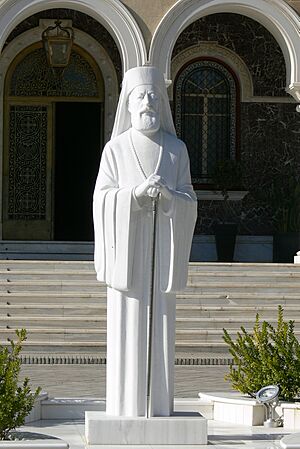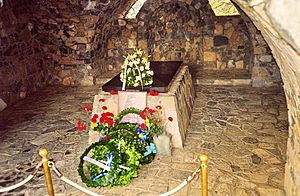Makarios III facts for kids
Quick facts for kids
His Beatitude
Makarios III
|
|
|---|---|
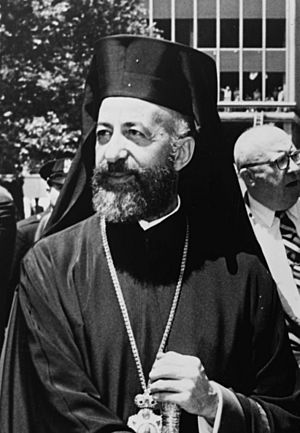
Archbishop President Makarios in New York City in 1962.
|
|
| 1st President of Cyprus | |
| In office 16 August 1960 – 15 July 1974 |
|
| Vice President | Fazıl Küçük (1959–1973) Rauf Denktaş (1973–1974) |
| Succeeded by | Nikos Sampson (de facto) |
| In office 7 December 1974 – 3 August 1977 |
|
| Vice President | Vacant |
| Preceded by | Glafcos Clerides (acting) |
| Succeeded by | Spyros Kyprianou |
| Archbishop of Cyprus | |
| In office 18 September 1950 – 3 August 1977 |
|
| Preceded by | Makarios II |
| Succeeded by | Chrysostomos I |
| Personal details | |
| Born | 13 August 1913 Panayia, Paphos District, British Cyprus |
| Died | 3 August 1977 (aged 63) Nicosia, Cyprus |
| Political party | None |
| Alma mater | University of Athens Boston University |
| Profession | Clergyman |
| Signature |  |
Makarios III (Greek: Μακάριος Γ΄), born Michael Christodoulou Mouskos, was a very important leader from Cyprus. He was an archbishop (a high-ranking church leader) and became the first president of Cyprus. Many people consider him the "Father of the Nation" for his role in Cyprus's independence. He was also the head of the Church of Cyprus from 1950 to 1977.
Contents
Becoming a Leader: Early Life and Church Career (1913–1950)
Michael Christodoulou Mouskos was born in Panayia village in the Paphos District. The name Makarios means "happy" or "blessed" in Greek. When he was 13, he joined Kykkos Monastery to become a monk. He later studied theology and law at the University of Athens during World War II. After graduating, he became a priest in the Cypriot Orthodox Church. He also studied more in the United States at Boston University.
In 1948, while still studying, he was chosen to be the Bishop of Kition. He took the name Makarios and returned to Cyprus. Like many Greek Cypriot leaders at the time, he strongly supported "enosis." This was the idea of Cyprus joining with Greece.
Leading the Nation: Archbishop and Independence Efforts (1950–1960)
In 1950, at just 37 years old, Makarios became the Archbishop of Cyprus. This made him the official head of the Orthodox Church in Cyprus. He also became the "Ethnarch," which meant he was seen as the national leader of the Greek Cypriot people. This powerful position put him at the center of Cypriot politics.
Makarios became very popular among Greek Cypriots. He actively pushed for "enosis," the union of Cyprus with Greece. In 1954, Greece, partly because of Makarios, asked the United Nations to discuss Cyprus's future. They wanted Cyprus to have "self-determination," meaning its people could choose their own future. Many hoped this would lead to Cyprus joining Greece.
However, the British government, which ruled Cyprus, did not want to give up the island. Cyprus was important to them for military reasons in the Middle East. In 1955, a group called EOKA (National Organization of Cypriot Fighters) was formed. This group fought for independence and union with Greece. Makarios shared their goals, but he later said he was not involved in their violent actions.
Exile and the Push for Independence (1955–1960)
In 1955, Greece again asked the United Nations about Cyprus. The British government in Cyprus tried to stop protests for union with Greece. But Makarios continued to demand self-determination for Cyprus.
The situation became difficult. In October 1955, the British governor, Sir John Harding, started talks about Cyprus's future. But Makarios was seen as too involved with the independence movement. So, in March 1956, British officers arrested Makarios and sent him away. He was exiled to the Seychelles Islands.
During this time, the Turkish Cypriot community started talking about "Taksim," which meant dividing the island. They worried about being treated unfairly in a Greek Cyprus. They wanted part of the island to stay under British or Turkish control. This made the situation in Cyprus even more complicated, with two groups wanting very different futures for the island.
Makarios was released after a year, but he could not return to Cyprus. He went to Athens, Greece, where he was welcomed as a hero. From Athens, he continued to work for enosis. He attended UN meetings to discuss the Cyprus issue.
Eventually, Greece decided that full union with Cyprus might not be possible. They started to support the idea of an independent Cyprus. In 1959, the Zurich Agreement was made, which set the stage for Cyprus's independence. Makarios was invited to London to finalize the plan. At first, he did not want to accept it. Some people believe he was pressured by the Greek and British governments to agree.
The new constitution for Cyprus was seen by some as unfair. It gave many special rights to Turkish Cypriots and allowed Britain to keep two military bases. Many felt it did not truly serve the people of Cyprus.
On March 1, 1959, Makarios returned to Cyprus. Huge crowds came out to welcome him. In December 1959, he won the first presidential election with two-thirds of the votes. He became the political leader of all Cyprus.
Leading an Independent Cyprus: President Makarios (1960–1963)

After his election, Makarios worked with the Vice-President, Dr. Fazıl Küçük, to plan Cyprus's future. Makarios now understood that joining Greece was not going to happen. He believed that independence was the best way for Cyprus to have peace. He became president on August 16, 1960, the day Cyprus became independent from Britain.
Makarios adopted a policy of "non-alignment." This meant Cyprus would not strongly side with either the Western (like the US and UK) or Eastern (like the Soviet Union) powers. He tried to have good relationships with both Turkey and Greece. Cyprus also joined the Commonwealth of Nations in 1961.
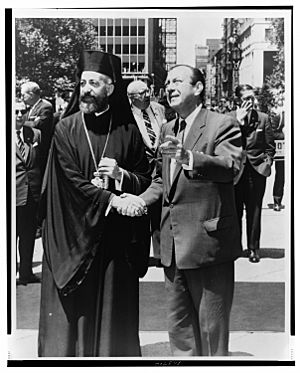
Makarios's non-aligned policy worried some Western countries. The American press even called him the "Castro of the Mediterranean." However, in Britain, he was sometimes called "Black Mak" because of his black church clothes.
At home, there were growing disagreements between Turkish and Greek Cypriots about how the constitution worked. In November 1963, Makarios suggested 13 changes to the constitution. He believed these changes would make the government work better and bring the communities closer. However, many Turkish Cypriots saw these changes as a threat to their rights.
In response, most Turkish Cypriots in government positions resigned. Many Turkish Cypriots also moved from mixed areas to villages and towns where most people were Turkish Cypriot. Some say this was due to fear, while others believe it was part of a plan for partition. By the end of 1963, fighting broke out between the two communities.
Challenges and Return: The Cyprus Problem (1964–1977)
The political situation in Cyprus remained difficult. UN peacekeeping forces arrived in 1964 to help calm things down. Makarios continued his neutral stance. But he struggled to convince Turkish Cypriots that they would be safe in an independent Cyprus. He also couldn't convince Greek Cypriots that independence was better than joining Greece.
In 1968, Makarios held new elections and won by a huge margin (about 96% of the votes). This showed that most Greek Cypriots supported his leadership and an independent Cyprus. He said that the Cyprus problem should be solved peacefully through the UN. He wanted all citizens to have equal rights in a united country. Still, some Cypriots disagreed with his peaceful approach, and there was even an attempt to assassinate him in 1970.
In 1967, a military government took power in Athens, Greece. This government did not get along well with Makarios. Makarios felt they were trying to weaken his power by supporting groups that still wanted enosis.
In 1971, tensions grew between the two Cypriot communities. George Grivas, a Greek-Cypriot soldier, secretly returned to the island. He started rebuilding his guerrilla group, EOKA B. This group, supported by the Greek military government, aimed to force Makarios out and achieve enosis.
The Greek government wanted to remove Makarios. They backed Grivas, who launched attacks and spread propaganda against Makarios's government. But Makarios remained a strong and popular leader. Relations between Cyprus and Athens became very bad. The Greek government even demanded that Makarios remove ministers who criticized them. Makarios eventually agreed to some changes in his government.
Another problem for Makarios was that many officers in the Cypriot National Guard were Greek soldiers who supported the Greek government. They also wanted to remove Makarios and achieve enosis. Grivas continued to be a threat. He was very against any plan that did not lead to complete union with Greece.
In 1972, Makarios faced a challenge from within the Church. Three bishops demanded that he resign as president, saying his political role went against church rules. Makarios managed to remove these bishops in 1973. He then increased the number of bishops to five, which reduced the power of individual bishops.
Grivas's efforts to achieve enosis through violence led to a civil struggle among Greek Cypriots. By late 1973, Makarios's forces had gained the upper hand. In November 1973, a new, harder-line military leader, Dimitrios Ioannidis, took power in Greece. Grivas died in January 1974, still unsure of Ioannidis's plans for Cyprus.
Makarios tried to make peace with Grivas's followers by offering them amnesty. He hoped EOKA-B would stop being a violent group. Many members accepted the amnesty. However, Ioannidis secretly ordered the remaining EOKA-B members to overthrow Makarios.
Overthrow and Return (1974)
On July 2, 1974, Makarios wrote a letter to the Greek government. He demanded that all Greek military officers leave Cyprus because they were undermining his government. He refused a compromise to choose new officers himself.
Four days later, on July 15, 1974, Ioannidis launched a coup d'état in Nicosia. Makarios managed to escape to Paphos and was rescued by a British helicopter. He then fled Cyprus. At first, there were false reports that he had been killed. Nikos Sampson, a newspaper editor who supported enosis, was put in charge as the new president.
On July 19, Makarios spoke to the United Nations Security Council. He called the coup an "invasion" by the Greek military government that had "violated the internal peace of Cyprus." Just five hours after his speech, Turkey invaded Cyprus. Under an agreement called the Treaty of Guarantee, Britain, Greece, and Turkey were supposed to work together to restore Cyprus's constitution.
The Greek government was collapsing at this time. Makarios, while in London, urged the British Prime Minister, Harold Wilson, to tell the Turkish Prime Minister that it was not in Turkey's interest for Cyprus to become part of Greece.
The Turkish invasion happened on July 20. Today, a part of Northern Cyprus is still occupied by the Turkish Army. To Turks and Turkish Cypriots, this is called a "peace operation" to protect the Turkish Cypriot community. However, international courts have called it an armed conflict.
Sampson's presidency did not last long. The Greek government in Athens collapsed a few days after the Turkish invasion. Sampson resigned on July 23, and Glafcos Clerides became president. Makarios stayed in London for five months. He worked to get international support for his government as the rightful one for all of Cyprus. He then returned to Cyprus, focusing on uniting the island. However, he was not successful, and the political situation of the island remains unresolved.
Death and Legacy
Makarios III died of a heart attack on August 3, 1977. He had been having heart problems earlier that year. His heart was removed during an autopsy and is kept in his former bedroom at the Archbishop’s Palace. He is buried in a tomb on Mount Throni, a place he chose himself, near Kykkos Monastery where he had studied as a young man.
His funeral was held at Saint John's Cathedral in Nicosia. Many important people from 52 countries attended. About 250,000 mourners, which was half the Greek Cypriot population, came to pay their respects.
To honor him, a large bronze statue of Makarios was placed outside the Archbishop's Palace in Nicosia. In 2008, this statue was moved to Kykkos Monastery and replaced with a marble statue of Makarios.
Titles and Honors
Titles
- 1913–1942: Michael Christodoulou Mouskos
- 1942–1948: The Reverend Father Michael Christodoulou Mouskos
- 1948–1950: The Right Reverend Michael Christodoulou Mouskos, Bishop of Kition
- 1950–1960: His Beatitude Makarios III, Archbishop of Nova Justiniana and All Cyprus
- 1960–1977: His Beatitude Makarios III, Archbishop of Nova Justiniana and All Cyprus, President of the Republic of Cyprus
Awards
- Grand Cordon of the Order of the Nile
- Special class of the Grand Cross of the Order of Merit of the Federal Republic of Germany
- Grand Master of the Order of Orthodox Hospitallers
See also
 In Spanish: Makarios III para niños
In Spanish: Makarios III para niños
- Foreign relations of Cyprus


